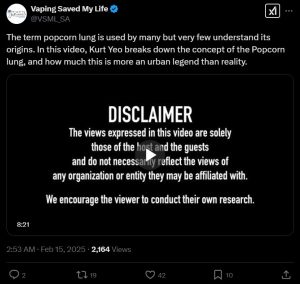Vapers Digest 17th February

Monday’s News at a glance:
GFN Photo Festival ~ GB Pouch Use Revealed ~ Nicotine less harmful to the brain than previously thought: study ~ Media Watch: More BBC Fear Mongering Over Pouches ~ Denver vs. The FDA ~ Africa: Harm Reduction in Smoking – Prof. David Khayat Advocates for a Pragmatic Approach ~ Is Vaping Really as Bad as Smoking? ~ Smoking rates in New Zealand have fallen TWICE as fast as Australia, new expert study finds ~ Tobacco and Vapes bill ~ Opinions – Everyone Has Them ~ Consumers be heard on vaping, before it is too late ~ A full guide to vapes: Post 1. Understanding vape aerosols ~ Young adults more likely to switch from smoking to vaping when aware of reduced harm, but misinformation deters change ~ Happy 10th birthday NNA! ~ France Becomes Second EU Country to Ban Disposable Vapes ~ Sell Flavored Tobacco in Massachusetts, Go To Jail ~ Study that fails to link youth vaping with future smoking brings up research issues ~ Roberto Sussman | Censorship & Misconduct in Tobacco Harm Reduction ~ MEXICO’S SMOKING RATES STAGNATE | Featuring Tomás O’Gorman
Two from Dave Cross, Planet of the Vapes
GFN Photo Festival
The Global Forum on Nicotine (GFN) team has announced the introduction of a brand new, exciting addition to #GFN25: the GFN Photo Festival. The competition will build on this year’s conference theme “Challenging perceptions – effective communication for tobacco harm reduction”. The GFN25 team says the GFN Film Festival, GFN Photo Festival and GFN Fives all provide exciting opportunities for consumers and others involved in tobacco harm reduction “to portray it as they know and live it”.
GB Pouch Use Revealed
New research from the Institute of Psychiatry, Psychology & Neuroscience (IoPPN) at King’s College London illustrates nicotine pouch use in Great Britain. The study places use at 1% in Youths and Adults, with overall use doubling in a four-year period. The UK Government is currently looking at more ways to clamp down on the pouch market.
Nicotine less harmful to the brain than previously thought: study
SnusForumNet
A comprehensive new study contradicts claims about nicotine’s supposed harmful effects on the brain, revealing that nicotine use is an effect – rather than the cause – of variations in brain structure. The study, published in the Journal of the American Medical Association (JAMA), analyzed brain images of nearly 10,000 adolescents aged 9 to 11 and followed them for three years to see how their brains are affected when they use different substances.
Media Watch: More BBC Fear Mongering Over Pouches
The Daily Pouch
In November 2024, Penn State University released a remarkable finding about social media. After analysing 35 million social media posts between 2017 and 2020, the researchers found that “around 75% of the shares were made without the posters clicking the link first.” [1] That’s right; for every four posts that are shared on social media, only one person actually reads the article. Headlines are what drive virality. More worryingly, they’re also what shapes public opinion.
Denver vs. The FDA
Kelly Sloan, Colorado Politics
Denver City Council’s crusade against flavored nicotine products continues to vex those of us who, as a matter of civic responsibility, desire to see a marked reduction in the smoking of tobacco, particularly among youth. The question, from a public policy perspective, becomes one of how to reduce the societal harms of smoking, the predominant of which is the risk of cancer.
Africa: Harm Reduction in Smoking – Prof. David Khayat Advocates for a Pragmatic Approach
Mame Maimouna Sy, Cindy Damaris, All Africa
World Cancer Day was celebrated on February 4, providing an opportunity for oncologists and scientists to discuss new ways to combat this devastating disease. During his visit to Dakar in Senegal, Professor David Khayat, a medical oncologist at the Bizet Clinic in Paris and former president of the French National Cancer Institute, gave an exclusive interview to allAfrica. In the interview, he advocates for a pragmatic approach to smoking control, emphasizing harm reduction strategies.
Maia Szalavitz, New York Times
Nearly 29 million Americans regularly smoke cigarettes, a drastic decline from 1964 when more than 40 percent of all adults smoked, and the surgeon general first linked tobacco to cancer. Still, that’s a lot of people hooked on nicotine. In an effort to end these addictions and prevent new ones, the Food and Drug Administration in the Biden administration’s last days proposed a plan that, if finalized, would require tobacco companies to reduce the level of nicotine in their cigarettes to doses below those associated with addiction.

Smoking rates in New Zealand have fallen TWICE as fast as Australia, new expert study finds
Ali Anderson, Clearing The Air
- New study compares New Zealand’s progressive policies on vapes with Australia’s restrictive approach.
- Adult daily smoking rates in New Zealand fell by 10 per cent per year over seven years.
- In contrast, Australia’s smoking rate dropped by only five per cent per year.
- The decline in smoking mirrored the vaping rates in the two countries. S
- moking rates fell three times faster in New Zealand’s lowest socioeconomic communities compared to Australia’s.
- New Zealand shows no significant evidence of illicit trade while Australia has a rampant and often violent black market.
Tobacco and Vapes bill
Institute of Economic Affairs, Christopher Snowdon
Prohibition has never been an unalloyed success, to put it gently. The generational tobacco ban proposed in the Tobacco and Vapes Bill has never been tried before and would represent the first attempt to prohibit the sale of tobacco, albeit gradually, in a European country since the 17th century. The idea is to effectively raise the age at which people can buy tobacco every year from 2027 until it is completely illegal. In practice, we can be almost certain that, within a few years, anti-smoking campaigners will call for a ‘level-playing field’ in which people are of all ages are banned from buying tobacco products.
Opinions – Everyone Has Them
Skip Murray, Skip’s Corner, Let’s Talk!
My brain is constantly whirling with thoughts, and my entire being is flooded with emotions. It is almost impossible for my mind to be still. I rarely experience inner calm and quiet, and knowing what peace feels like is hard. Since I was a little girl, I have kept a journal. It has hopes and dreams, funny stories, and cherished memories. However, it is also filled with darkness—the things no one should have to experience, the things I wish I could forget.
Consumers be heard on vaping, before it is too late
Richard, Substack
Below is a copy of the letter sent on 11th Feb. The government is about to make a major mistake that will cost lives and prevent people from switching to vastly safer alternatives. I suggest that others write if they feel strongly and explain the situation from a user’s point of view. It seems that the NGOs and trade associations for manufacturers have been asked, but no one represents consumers.
A full guide to vapes: Post 1. Understanding Vape Aerosols
Roberto Sussman, Substack
This is the first Substack post of a series of posts describing how vapes work, the aerosol they generate, their properties, their optimal regime of operation, overheating conditions and dry puffs, as well as comparisons with tobacco smoke and other aerosols. Understanding how vape aerosols form, operate and can be tested provides the knowledge to understand their pleasurable usage, their toxicity profile and relative safety with respect to tobacco smoke and other aerosols and pollutants.
Young adults more likely to switch from smoking to vaping
when aware of reduced harm, but misinformation deters change
University of Bristol
Young adults are more likely to give up smoking and switch to vaping if they understand the reduced harm of vaping, according to a new study involving University of Bristol researchers. However, many inaccurately believe that vaping is as bad for you or worse than smoking. The study, published in Nicotine and Alcohol Research and led by a team at Brighton and Sussex Medical School, found that, among young adults who smoked at age 23/24 years perceived vaping as less harmful than smoking was associated with switching from smoking to vaping six years later.
Happy 10th birthday NNA!
Michelle Jones, Ecig Click
The NNA (New Nicotine Alliance) was created 10 years ago and is still going strong! About The NNA & Their Work Trustees of the organisation had previously met while fighting against the European Union’s Tobacco Products Directive, alongside other European consumers, which was attempting to regulate e-cigarettes to be licensed only as medicinal products. This was a clear attempt by the EU to eradicate vaping in its infancy.
France Becomes Second EU Country to Ban Disposable Vapes
Jim Mcdonald, Vaping 360
France has become the second European Union country to pass a ban on the sale of disposable vapes, after a final parliamentary vote held Thursday. A similar disposable ban in EU member Belgium took effect Jan. 1. The new law was passed yesterday by the French Senate, the upper house of Parliament. It was first passed in December 2023 by the lower house of Parliament, the National Assembly. The final, amended bill was voted on after a joint Senate-National Assembly committee met in January to iron out differences between the legislative bodies.

Sell Flavored Tobacco in Massachusetts, Go To Jail
Jacob Grier, Reason
In 2022, I wrote an article for Reason predicting that it was only a matter of time before selling flavored tobacco products landed an American behind bars. Almost three years later, that day has arrived in Massachusetts. According to a press release from the Middlesex district attorney and the Department of Revenue, the owner of a Marlborough vape shop has pleaded guilty to three counts of attempted tax evasion arising from the sale of e-cigarettes brought in from across state borders. He was sentenced to serve six months in the House of Correction and five years probation.
Barnaby Page, Tobacco Intelligence
New research “fails to show that youth vaping causes future smoking,” announces the University of Massachusetts Amherst. Hold the front page (and open the champagne if you’re a harm-reduction advocate)? Not so quick, perhaps, because one of the more significant things about the study is precisely that it “fails to show”. It does not demonstrate anywhere near conclusively the absence of a link between youth vaping and the later take-up of combustibles; it just doesn’t find any overwhelming evidence for a link. And this, although it might be disappointing for the researchers (who would presumably have liked a more definitive takeaway), illustrates several of the issues that have long plagued the intersection of tobacco harm reduction (THR), science and public policy.
Roberto Sussman | Censorship & Misconduct in Tobacco Harm Reduction
TobaccoHarmReduction
In this podcast we dive deep into the controversial world of academic misconduct and censorship in the tobacco harm reduction space. Our guest, Dr. Roberto Sussman, is a senior researcher in theoretical physics at the National Autonomous University of Mexico (UNAM) and an advocate for scientific integrity, dedicated to harm reduction and evidence-based policy on nicotine use.
MEXICO’S SMOKING RATES STAGNATE | Featuring Tomás O’Gorman
Global Forum on Nicotine
Mexico’s smoking rates have stagnated, so why is the government insisting on amending their constitution to ban vapes? Tomás O’Gorman joins us to explain these latest developments in Mexico in this brand new episode of GFN News!
On this Day…2023
A look back at how things have moved on or otherwise…
Exposing Defective Research…
But Denied Credit for the Effort: Case 1 – Brad Rodu
I have catalogued in this blog numerous instances of deficient research that has been published by respected medical journals. In some cases, journal editors have published our concerns and authors’ corrections (here).
7 Things Policy Makers and Journalists
Need to Know – Charles A. Gardner
With hyperlinks to the evidence:
The death toll from smoking is staggering – Harm reduction can reduce that death toll – Safer nicotine alternatives help smokers quit – Teen nicotine vaping is undesirable, but not a “crisis” – Proposed policy “cures” are worse than the “disease” – Inconsistent definitions and exaggerated teen “use” should not drive policy – Full context of adult products that teens should not use
Visit Nicotine Science & Policy for more News from around the World







